Microfluidic Workshop 2018

The third annual “How to Make It and Use It” Microfluidic Workshop, presented by the Center of BioModular Multiscale Systems for Precision Medicine, was hosted this year at the University of Kansas August 1-3, 2018. Twenty participants came to KU from Arkansas, Kansas, Louisiana, Missouri, and Oklahoma to learn how to fabricate a microfluidic device, and how the process of making and using it could be applied to many areas of research.
The workshop participants spent the first and second mornings listening to talks given by CBM2 faculty, researchers, and guest lecturers. The first morning of talks covered topics related to patterning structures across different length scales such as patterning micro- and nanostructures using micromilling, optical lithography, etching, PDMS casting, focused ion beam lithography and e-beam lithography; replication techniques such as hot embossing, injection molding, nanoimprint lithography; and counting cells using the Coulter Counter. During the morning of the second day, workshop participants heard talks on applications in which microfluidics can be used. Topics included different materials for microfluidics, metrology, 3D printing, designing a microfluidic, and engineering principles.
After the morning talks, the workshop participants enjoyed lunchtime discussions with the CBM2 faculty, followed by a hands-on laboratory experience where what they learned in the morning lectures could be translated into the lab. In addition to preparing their own micro-Coulter Counter in the lab, participants took tours of the KU Nanofabrication Facility cleanroom and learned how to use a hot embossing machine.
On the second evening of the workshop, participants met at the KU Adams Alumni Center for dinner and a talk by guest speaker Dr. David Kaufman of the University of North Carolina at Chapel Hill. Dr. Kaufman presented an engaging lecture titled, “Moving New Technologies into the Clinic” that walked the audience through the basics of cancer biology, and how the technologies coming from researchers such as those at CBM2 are being used in the clinical setting to improve patient care.
The third and final day of the workshop was spent entirely in the lab, with participants performing experiments using the micro-Coulter Counters they created the previous two days. In the experiment, the participants made a micro-Coulter Counter to determine the size of particles and the concentration of the particles in a fluid sample. They made a microfluidic chip via hot embossing, which contained a microfluidic channel and a Coulter Counter.